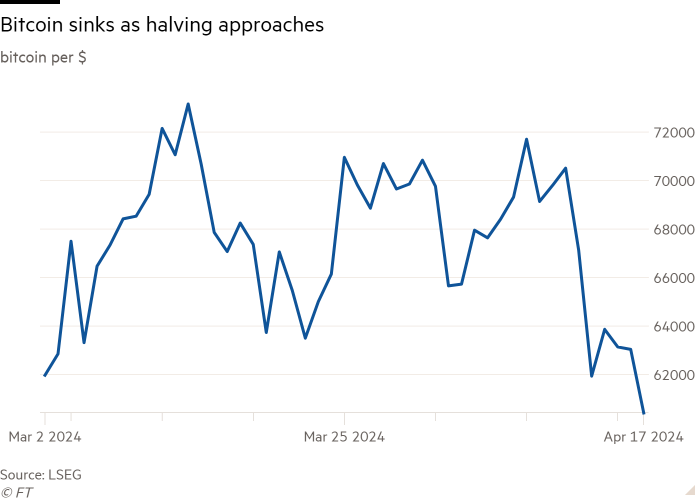Unlock the Editor’s Digest for free
Roula Khalaf, Editor of the FT, selects her favourite stories in this weekly newsletter.
Cryptocurrency miners are stockpiling near-record amounts of bitcoin, hoping the token will rise in value and offset a drop in new supply that will cut the rewards for verifying deals in half.
Listed miners such as Marathon Digital, CleanSpark and Bitfarms have hoarded bitcoin collectively worth about $2.8bn, according to data provider The Miner Mag, days before the reward for mining is cut in half.
After the change, due to take place on Friday, global miners will share a total of 450 new bitcoins daily, down from 900, for verifying the latest transactions in bitcoin. The quadrennial move was designed with the creation of the cryptocurrency and intended to hedge against inflation.
Hedge funds have long been betting against listed crypto miners, with the “halving” seen as a likely hit to their profitability, and their share prices have fallen this year. The industry spends heavily on energy and technology to compete to win each new bitcoin and inefficient miners are expected to be pushed out of the market as production costs rise.
“Mining companies are playing a constant game of chicken with each other,” said Larisa Yarovaya, associate professor of finance at the University of Southampton. “It’s a business model that’s based more than ever on faith that bitcoin’s price will go up and demand for it will grow.”
To offset the decline, crypto executives and traders are betting that bitcoin, which hit a record high last month, will rise further this year and follow a trend established after three previous halvings.
Miners are holding 46,200 coins in reserve, the highest recorded number since May 2022, when a marketwide crash forced miners to sell their holdings, The Miner Mag found.
US-based Cleanspark held more than 5,000 bitcoins at the end of March, up 2,400 per cent on the same month a year ago. Marathon Digital has increased its holdings 50 per cent to 17,300 bitcoins, while Bitfarms and Riot have increased their holdings by 50 per cent and 20 per cent respectively.
“Everyone is hopeful bitcoin will go up in value and that will solve rewards being cut in half,” said Matthew Schultz, executive chair at CleanSpark.

That optimism has been fuelled by bitcoin’s 121 per cent rise in the past six months as US regulators approved stock market funds that invest directly in bitcoin. Bitcoin surged to a record high of $73,800 in mid-March but has dropped more than 14 per cent this month, to less than $60,000 on Wednesday.
“Bitcoin is going to be worth more in the future than it is today,” said Asher Genoot, chief executive of Hut 8, a US miner.
Miners have struggled for profitability after a debt-fuelled expansion in the 2021 crypto bull market was curtailed by a crash. But as the latest halving approached, miners spent more than $1bn on new equipment to gain market share and squeeze out competitors.
However, hedge fund short sellers continue to run sizeable bets against a number of miners. About 24 per cent of Marathon’s shares are out on loan — a strong indicator of short interest, according to S&P Global Market Intelligence. This is less than the more than 50 per cent reached early last year, but still greater than at the start of 2024.
Short interest in Hut 8 has risen this year from less than 10 per cent to more than 14 per cent, while bets against Riot Platforms have dipped slightly this year but are still more than 19 per cent of the shares.
Miners are also hoping for increased activity on the bitcoin network to boost transaction fee revenue, driven by developments such as trading non-fungible tokens.
“All of this is extremely nascent, it’s far too early to tell whether, in the long run, this will be sufficient to keep mining activity economically viable,” said Andrew O’Neill, managing director of S&P Global’s digital assets research lab.
Additional reporting by Laurence Fletcher







